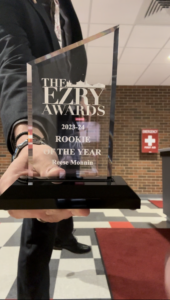
Have you ever wondered what it is like to go through rapids? There are many who can say they never have thought of it, just like many students in English 180, Wilderness Writers. In this class, offered during spring semesters, students explore contemporary and classic stories inspired by wilderness exploration, survival, and adventure. An emphasis is placed on examining a writer’s treatment of human experiences in the wild, as well as close readings of texts using key elements of narrative writing.
The River by Peter Heller is one of the books that was read in the class. This book follows the journey of two friends, Wynn and Jack, as they embark on a wilderness canoe trip in northern Canada. The story unfolds as the friends encounter the beauty and danger of nature, with them trying to outrun an oncoming wildfire, as well as the complexities of their own relationship. As they navigate the river’s twists and turns, they must confront not only the challenges of the wilderness but also the moral dilemmas that arise when they come across a violent situation involving other travelers.
This story inspired the course’s professor, Andy Graff, to add a hands-on learning experience to his class. Graff, author of True North and Raft of Stars, has been a white-water rafting instructor during his summers on the rivers of West Virginia. His seasoned experience, along with help from another professor, allowed for his class to learn how to go over rapids in kayaks.
The class had previously hiked down to Snyder Park to see where the rapids would be. Graff gave them some tips and warnings in anticipation of the actual event, Friday, April 12th. It was cold, cloudy, and spitting rain. It was not ideal weather conditions, and the water was frigid, but that did not stop the students from getting in their boats. The students were first told to put on a spray skirt, so water did not instantly get in the kayak, and all over them. They also had helmets and life jackets on, ensuring safety if they were to flip. Two students ended up flipping going over the rapids, one student falling twice.
Before getting in the water, Graff explained that if you flipped, you must pull off the spray skirt and get out of the kayak. It’s especially important not to stand up, and just let yourself float to the surface. The two students who flipped used this to keep safe. They reported that the water was freezing, but it was fun and worth it to them.
While waiting for everyone to get in their kayaks, the students just played around and got used to being in the boat. It felt very unstable at first, one little move and the kayak was rocking, but once they got used to it, it became easier. The students went one by one down the rapids, Graff going first to make sure everyone got through okay. The first rapid is the smallest, so it was easy going through it, but the rest got bigger as they went.
Snyder Park has 4 rapids that the students were able to go through. These are manmade rapids and are quite insignificant compared to some in mountains river valleys. Along with learning how to go through the rapids on a kayak, the students also learned how the river worked. The “V” shape that forms at the beginning of the rapid is called the tongue. This is a point of no return; once you go through it, you must keep going downstream. Once past the tongue, to get out of the rapid, you must cross the eddy line, where most people flip. Once past the eddy line, you are safe in the eddy, which is calm water that you can rest in.
Even though some people came out of that river wetter than others, everyone who participated in the class and the kayaking had an amazing time learning this skill. If you are interested in experiencing this yourself, try checking out this class!





